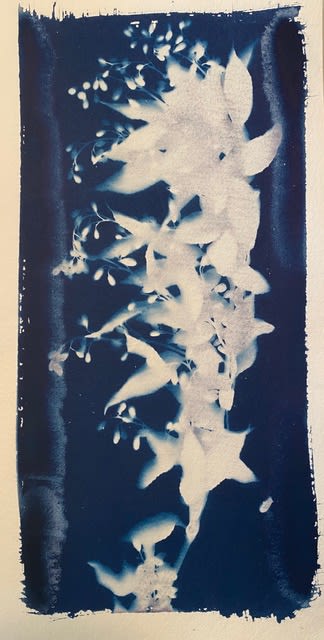The cyanotype process — from the Greek cyan or “dark–blue impression” — is nothing new in photography. Photographers have used it since its invention in 1842 to turn the whole world into a blue hue — some to make a first impression of their work before the definitive print, others to deliberately shift our perception.
Photographer Keris Salmon is one of the latter. Her new work, The Corona Greenhouse Blues, on view by appointment and online at Arnika Dawkins Gallery and online at Artsy through July 30, is a collection of botanical prints made while she isolated during Covid-19.

A Spray for George Floyd, 2020
“It was an anchoring process during a tumultuous time and it helped me keep a sense of regular patterns of life,” Salmon says. ”I feel at this time a strong connection to plants, flowers and birds, as they bear a spirit of normalcy that is missing in other dimensions right now.”
Salmon was working with what she found in abundance in her own garden, in anticipation of spring blooming in New England, where she lives. Her catalog ranges from highly eye–pleasing botanical species such as the Andromeda or the Siberian Squill, to more common ones such as stems of parsley or a palm branch. The cyanotype is, in this respect, a great equalizer, allowing the artist to elevate the most conspicuous subject into a piece of art.
“Blue is just magical,” Salmon says. It’s difficult to disagree. The color blue has a great seductive power and the cyanotype process has been making a comeback lately in the contemporary art world. In 2016, cyanotypes had their first full-blown museum exhibition, Cyanotypes: Photography’s Blue Period, at the Worcester Art Museum in Worcester, Massachusetts.
Anna Atkins is considered by many to be the first female photographer and the first person to create a book of photo-based images in botanical cyanotypes in the 1840s. She still inspires many contemporary artists, including Salmon.
Cyanotype was invented by British astronomer and chemist John Frederick Herschel (1792–1871) and was first used to easily reproduce architectural drawings, thus giving birth to the term “blue print.” Making a cyanotype involves placing a negative image — a photographic negative or an object such as a photogram — on paper treated with an iron-based solution. The paper is then placed under an ultraviolet light or directly under the sun to develop. Nuances can be introduced by using different types of paper or by letting the paper be more or less wet while being processed, resulting in different shades of blue.
Salmon’s cyanotypes are a departure from her central body of work, We have made these lands what they are: The architecture of slavery, a long-term project investigating the history of antebellum plantations in the American South. Her project has gained national recognition and was featured by Arnika Dawkins Gallery in spring 2018. Her botanical cyanotype series has no relation to the earlier work, except that it is itself a historical photographic process.
History was quickly unfolding as she worked on her floral prints. The racial justice protests that have risen across the United States moved her to rename one of her pieces — initially titled Fuzzy Pride of Rochester — to A Spray for George Floyd, in an effort “to subvert my rage and pay my respects.”


